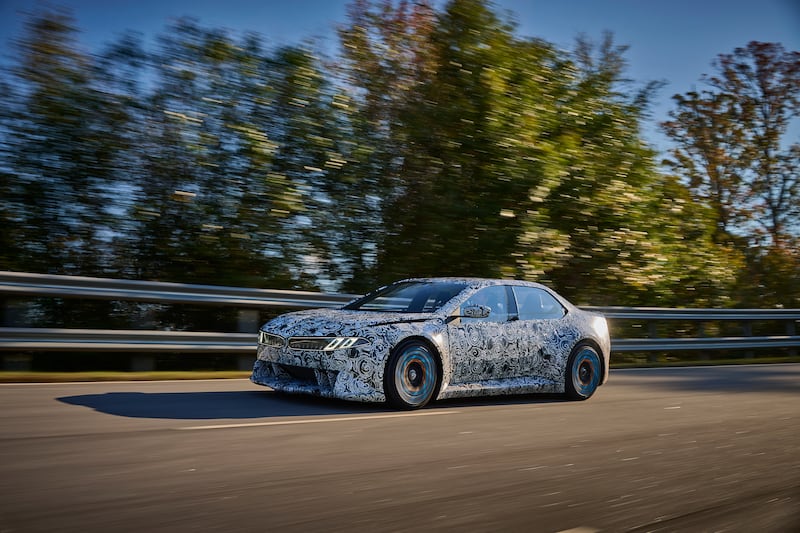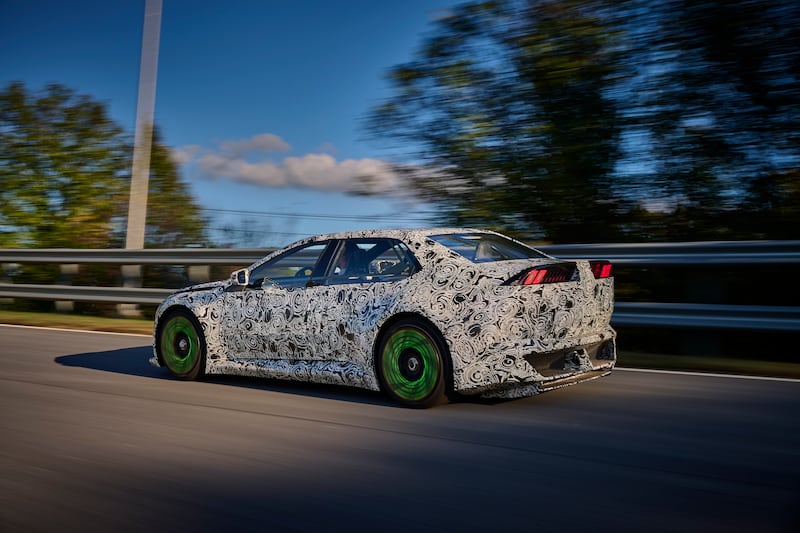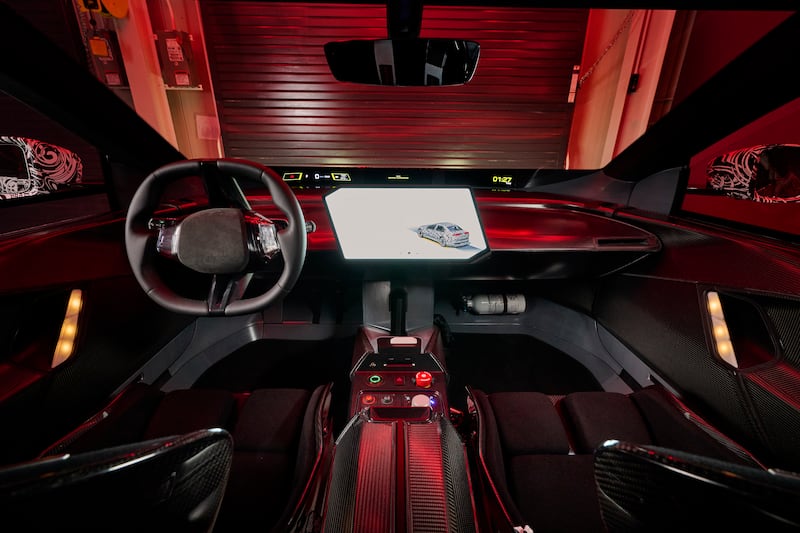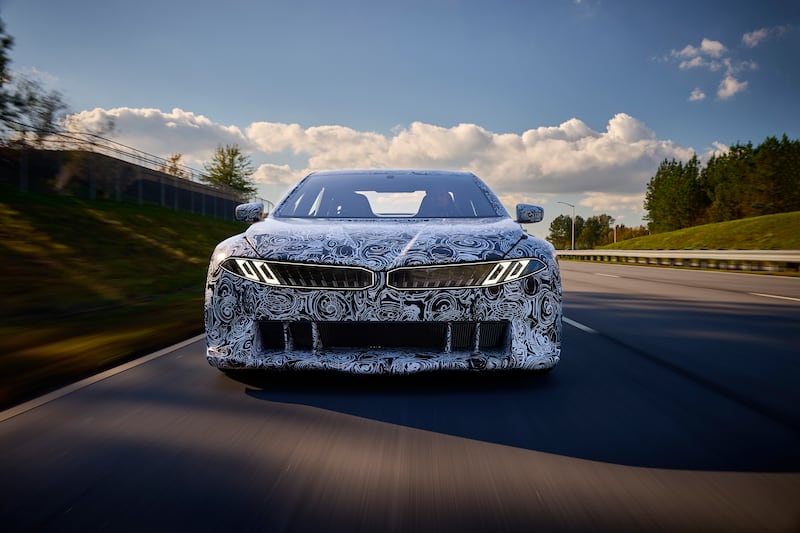The swirly camouflage of the vinyl wrap says it’s a prototype. BMW says not only is it a prototype, but it’s not for production. But the showroom-spec grille and lights say otherwise and, while presumably BMW bods had their fingers crossed behind their backs a moment ago, this one-off prototype of the all-electric Neue Klasse saloon, due to go into production late next year, is pretty clearly the new M3.
BMW won’t confirm as much just yet, but the signs are there. The bulging, almost touring-car-spec side skirts. The deep front air intake. The broad tyres on those big alloy wheels (which glow different colours according to when the car is accelerating, braking, or cruising – let’s hope that NEVER makes it to production). The way the rear bootlid and brake lights sweep upwards into a ducktail spoiler. We’ve seen the concept version of the regular Neue Klasse saloon up close and personal before, and it never looked as muscular as this.
Then there are the high-backed carbon fibre bucket seats and the plumbed-in fire extinguisher within. Clearly, this is a car that means business with a capital F. It also looks, even with the camouflage wrap, astonishingly desirable, triggering the 10-year-old-boy synapses to the point where you half expect to be able to pick it up and find the words “Hot Wheels” stamped underneath.
Whether this car will be called the i3M, the Mi3, or some other three-figure combination, this is almost certainly something close to the high-performance model of the 2027 all-electric BMW 3 Series. Normally, that’s an upcoming new model whose key performance figure is its expected 600-odd-kilometre range. With this one, the number is 18,000.
That’s 18,000Nm of torque, which is what BMW claims is delivered at the wheels of this development prototype. Now, that needs a major caveat. Torque figures measured at the wheels are notoriously difficult to quantify, and they’re actually kinda misleading. Even though this is a car with four individual electric motors, one for each wheel, measuring torque at those wheels – rather than at the motor itself – is notoriously inaccurate, as the maximum figure might only last for a microsecond or two.

Anyway, as with a proper power figure, we’ll have to wait and see but BMW is keen to start stress-testing the i3 and i3M’s suspension, brakes and electronic control units. That’s why this car is being put through its testing paces. “The reasoning behind this is that if the control system can deal with an explosion of power of this magnitude, it will be able to handle the demands of everyday driving with ease,” says BMW.
There’s a helping hand to allow the car to deal with that much wallop – downforce. Forget that swept-up bootlid, BMW has turned to electricity to give its new electric car the grip and traction it needs.
There are no fewer than five electric fans under the bodywork, which suck the air out from underneath the car, pinning it to the road in the fashion of a late-1970s Formula One “ground effect” car or, for that matter, like the current McMurtry Spéirling single-seat electric track car, which holds a series of racetrack and hill-climb records simply because it’s developing maximum downforce as soon as it starts.

Will such a system make it to production? Doubtless it would be a drain on the i3M’s battery if it does, but perhaps BMW is developing clever electronics to only activate the fans for short bursts when they’re needed.
Certainly plenty of clever electronics have already been developed for this car, as BMW is using it to stress-test its “Heart Of Joy” electronic brain. The Heart Of Joy may have a silly name but it’s deadly serious tech, developed in-house in Munich, which uses two big processing centres, each divided in two, which deal variously with the car’s driving dynamics, its efficiency, its performance, its advanced driver aids (and a smidgen of autonomous capability, apparently) and more mundane but vital stuff such as air conditioning and infotainment.

Aside from the big bucket seats, we can see inside the prototype that BMW is using the same button-free infotainment screen, with its offset rhombus shape, and the full-width windscreen display which is half-HUD, half-instrument panel. That set-up, along with the car’s 30 per cent more efficient batteries and motors, will make their debut in the production version of the new iX3 electric SUV, which goes on sale in 2026.
[ BMW previews a 600km-range iX3 replacementOpens in new window ]
In the meantime, BMW is torturing the systems with this i3M’s torque and performance. It’s not just about going quickly, either – the Heart Of Joy is also reckoned to be a range-saving system.
According to BMW: “Integrated drivetrain, braking and energy recuperation control allows energy to be used more sustainably. 98 per cent of drivers do not need to make any inputs using the conventional brakes. The braking power generated using energy recuperation is sufficient for normal, everyday driving. Only under heavy braking, eg in an emergency situation, is intervention required from the friction brakes. All in all, this system increases efficiency by up to 25 per cent.

“The Heart of Joy enables us to take driving pleasure not just to the next level, but another one beyond that,” said Frank Weber, BMW’s development and tech chief. “In addition, we are further increasing efficiency and therefore boosting range, as in future the driver will brake almost exclusively using energy regeneration. This is efficient dynamics squared.”
We should find out more about the Heart Of Joy, and possibly this muscle-bound “not for production” (wink, wink) prototype at the upcoming Shanghai motor show.





















